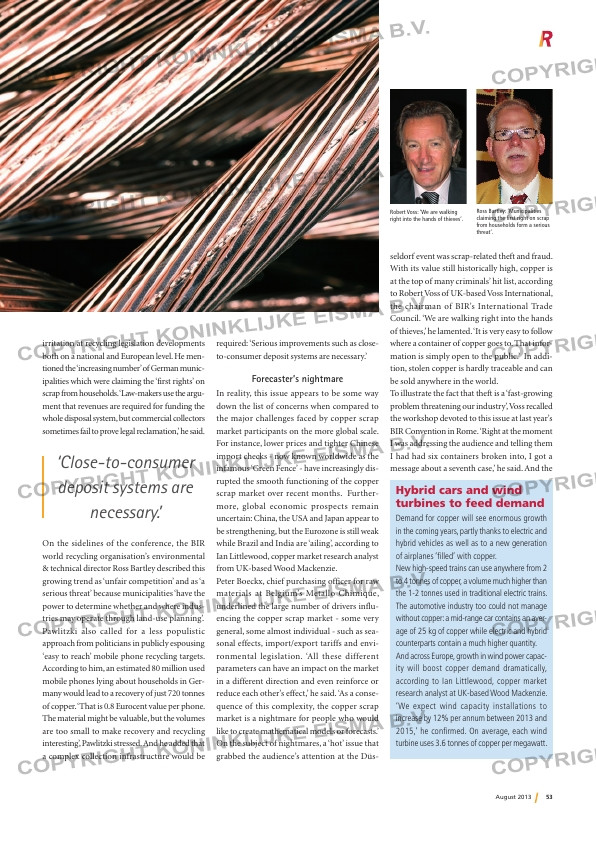Page 53 from: August 2013

53August 2013
irritation at recycling legislation developments
both on a national and European level. He men-
tioned the ‘increasing number’ of German munic-
ipalities which were claiming the ‘first rights’ on
scrap from households. ‘Law-makers use the argu-
ment that revenues are required for funding the
whole disposal system, but commercial collectors
sometimes fail to prove legal reclamation,’ he said.
On the sidelines of the conference, the BIR
world recycling organisation’s environmental
& technical director Ross Bartley described this
growing trend as ‘unfair competition’ and as ‘a
serious threat’ because municipalities ‘have the
power to determine whether and where indus-
tries may operate through land-use planning’.
Pawlitzki also called for a less populistic
approach from politicians in publicly espousing
‘easy to reach’ mobile phone recycling targets.
According to him, an estimated 80 million used
mobile phones lying about households in Ger-
many would lead to a recovery of just 720 tonnes
of copper. ‘That is 0.8 Eurocent value per phone.
The material might be valuable, but the volumes
are too small to make recovery and recycling
interesting’, Pawlitzki stressed. And he added that
a complex collection infrastructure would be
required: ‘Serious improvements such as close-
to-consumer deposit systems are necessary.’
Forecaster’s nightmare
In reality, this issue appears to be some way
down the list of concerns when compared to
the major challenges faced by copper scrap
market participants on the more global scale.
For instance, lower prices and tighter Chinese
import checks – now known worldwide as the
infamous ‘Green Fence’ – have increasingly dis-
rupted the smooth functioning of the copper
scrap market over recent months. Further-
more, global economic prospects remain
uncertain: China, the USA and Japan appear to
be strengthening, but the Eurozone is still weak
while Brazil and India are ‘ailing’, according to
Ian Littlewood, copper market research analyst
from UK-based Wood Mackenzie.
Peter Boeckx, chief purchasing officer for raw
materials at Belgium’s Metallo Chimique,
underlined the large number of drivers influ-
encing the copper scrap market – some very
general, some almost individual – such as sea-
sonal effects, import/export tariffs and envi-
ronmental legislation. ‘All these different
parameters can have an impact on the market
in a different direction and even reinforce or
reduce each other’s effect,’ he said. ‘As a conse-
quence of this complexity, the copper scrap
market is a nightmare for people who would
like to create mathematical models or forecasts.’
On the subject of nightmares, a ‘hot’ issue that
grabbed the audience’s attention at the Düs-
seldorf event was scrap-related theft and fraud.
With its value still historically high, copper is
at the top of many criminals’ hit list, according
to Robert Voss of UK-based Voss International,
the chairman of BIR’s International Trade
Council. ‘We are walking right into the hands
of thieves,’ he lamented. ‘It is very easy to follow
where a container of copper goes to. That infor-
mation is simply open to the public.’ In addi-
tion, stolen copper is hardly traceable and can
be sold anywhere in the world.
To illustrate the fact that theft is a ‘fast-growing
problem threatening our industry’, Voss recalled
the workshop devoted to this issue at last year’s
BIR Convention in Rome. ‘Right at the moment
I was addressing the audience and telling them
I had had six containers broken into, I got a
message about a seventh case,’ he said. And the
Hybrid cars and wind
turbines to feed demand
Demand for copper will see enormous growth
in the coming years, partly thanks to electric and
hybrid vehicles as well as to a new generation
of airplanes ‘filled’ with copper.
New high-speed trains can use anywhere from 2
to 4 tonnes of copper, a volume much higher than
the 1-2 tonnes used in traditional electric trains.
The automotive industry too could not manage
without copper: a mid-range car contains an aver-
age of 25 kg of copper while electric and hybrid
counterparts contain a much higher quantity.
And across Europe, growth in wind power capac-
ity will boost copper demand dramatically,
according to Ian Littlewood, copper market
research analyst at UK-based Wood Mackenzie.
‘We expect wind capacity installations to
increase by 12% per annum between 2013 and
2015,’ he confirmed. On average, each wind
turbine uses 3.6 tonnes of copper per megawatt.
Robert Voss: ‘We are walking
right into the hands of thieves’.
Ross Bartley: ‘Municipalities
claiming the first right on scrap
from households form a serious
threat’.
‘Close-to-consumer
deposit systems are
necessary.’
RI-6_Copper.indd 53 01-08-13 11:47



